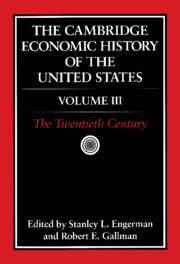Book contents
- Frontmatter
- 1 American Macroeconomic Growth in the Era of Knowledge-Based Progress: The Long-Run Perspective
- 2 Structural Changes: Regional and Urban
- 3 Twentieth-Century Canadian Economic History
- 4 The Twentieth-Century Record of Inequality and Poverty in the United States
- 5 The Great Depression
- 6 War and the American Economy in the Twentieth Century
- 7 U.S. Foreign Trade and Trade Policy in the Twentieth Century
- 8 U.S. Foreign Financial Relations in the Twentieth Century
- 9 Twentieth-Century American Population Growth
- 10 Labor Markets in the Twentieth Century
- 11 Labor Law
- 12 The Transformation of Northern Agriculture, 1910–1990
- 13 Banking and Finance in the Twentieth Century
- 14 Twentieth-Century Technological Change
- 15 The U.S. Corporate Economy in the Twentieth Century
- 16 Government Regulation of Business
- 17 The Public Sector
- Bibliographic Essays
- Index
4 - The Twentieth-Century Record of Inequality and Poverty in the United States
Published online by Cambridge University Press: 28 March 2008
- Frontmatter
- 1 American Macroeconomic Growth in the Era of Knowledge-Based Progress: The Long-Run Perspective
- 2 Structural Changes: Regional and Urban
- 3 Twentieth-Century Canadian Economic History
- 4 The Twentieth-Century Record of Inequality and Poverty in the United States
- 5 The Great Depression
- 6 War and the American Economy in the Twentieth Century
- 7 U.S. Foreign Trade and Trade Policy in the Twentieth Century
- 8 U.S. Foreign Financial Relations in the Twentieth Century
- 9 Twentieth-Century American Population Growth
- 10 Labor Markets in the Twentieth Century
- 11 Labor Law
- 12 The Transformation of Northern Agriculture, 1910–1990
- 13 Banking and Finance in the Twentieth Century
- 14 Twentieth-Century Technological Change
- 15 The U.S. Corporate Economy in the Twentieth Century
- 16 Government Regulation of Business
- 17 The Public Sector
- Bibliographic Essays
- Index
Summary
INTRODUCTION
When the twentieth century opened, there was an unusually high level of interest in the economic well-being of the working poor. The Bureau of Labor Statistics in Washington, D.C., the Statistics Bureau in Massachusetts, and the Heller Commission in San Francisco were doing the first quantitative studies of U.S. workers’ living standards. Robert Hunter, inspired by Europeans such as Booth, Rowntree, and Engel, was soon to give us our first important sociological study of poverty. The upper end of the income distribution was the object of no less scrutiny, as the Progressives fixed their eye on the monopolies and the new class of rich industrialists and professionals, who, they believed, wielded disproportionate political and economic power.
As the century drew to a close, there was renewed attention to these same issues. After two decades without economic progress for the working class, accompanied by highly visible accumulations of financial wealth by the top 1 percent, the routine publication of an income distribution report by the Census Bureau or a Congressional committee has turned into a political event. Article upon article detailing the recent rise in inequality must make it seem unprecedented to all but the most knowledgeable specialists. In fact, with regard to inequality at least, we are probably replaying the statistical record of a century ago.
- Type
- Chapter
- Information
- The Cambridge Economic History of the United States , pp. 249 - 300Publisher: Cambridge University PressPrint publication year: 2000
- 7
- Cited by



